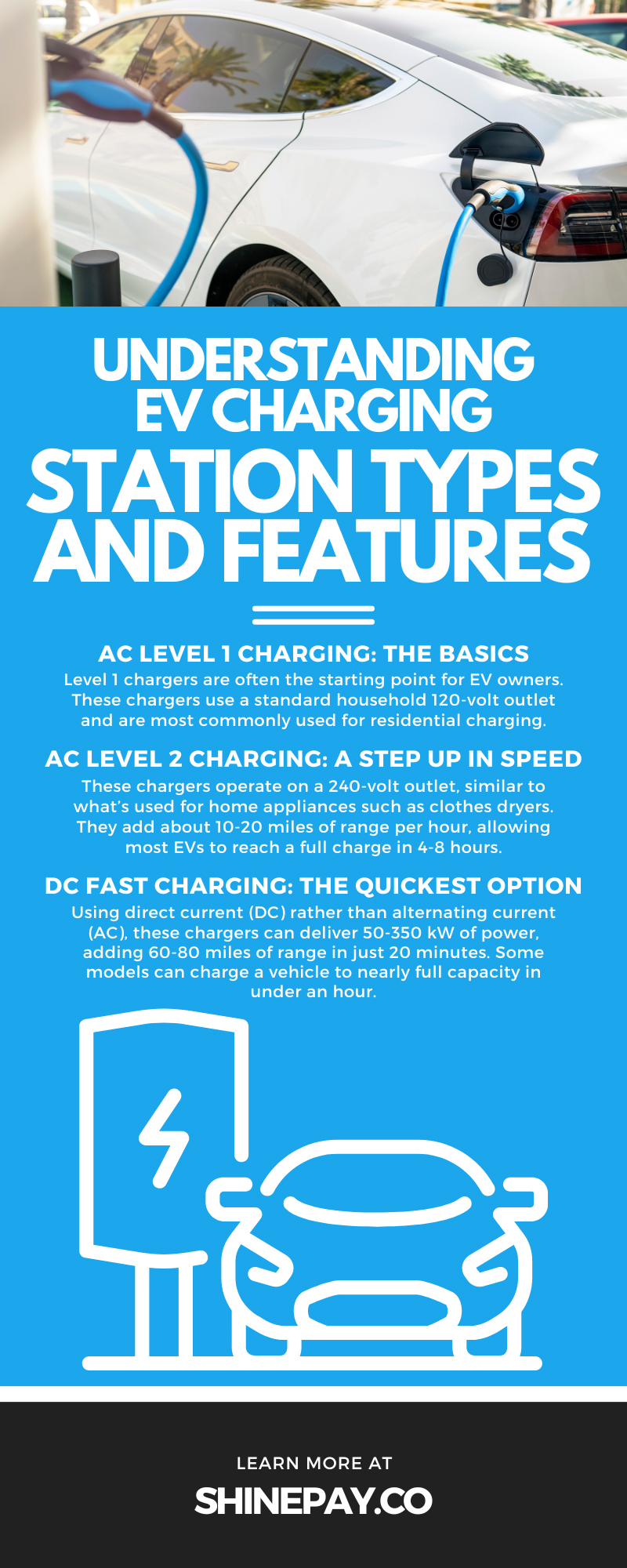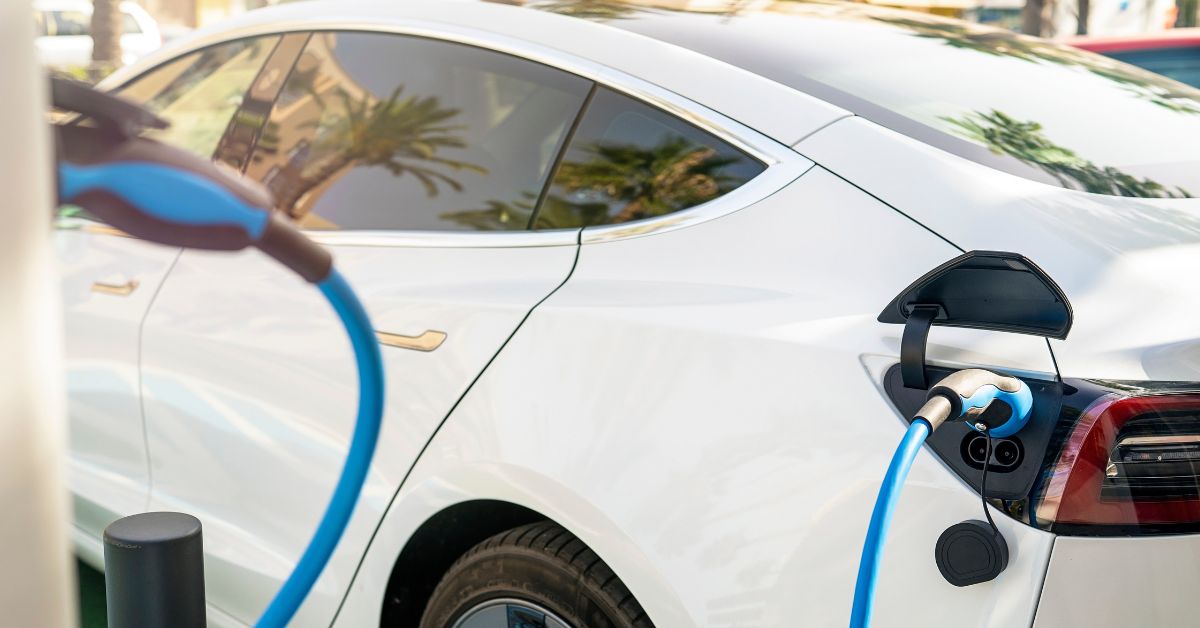Electric vehicles (EVs) are becoming more common on the roads every day, and with that comes the growing need for EV charging infrastructure. Whether you're a business owner looking to attract EV drivers or a property manager exploring ways to add value to your property, understanding EV charging station types and features is essential.
This guide explores the different types of charging stations, their essential features, and considerations to keep in mind before you invest in installation. By the end of this post, you'll feel confident in choosing the right EV charging solution for your business or commercial property.
AC Level 1 Charging: The Basics
Level 1 chargers are often the starting point for EV owners. These chargers use a standard household 120-volt outlet and are most commonly used for residential charging.
How It Works
AC Level 1 charging has a slow charging rate, adding approximately 2-5 miles of range per hour. To achieve a full charge, it can take anywhere from 12 to 24 hours, depending on the battery size.
Ideal Use Cases
This charging type is perfect for overnight charging. Many drivers opt for AC Level 1 chargers at home, where time isn't an issue. For businesses, however, this may not be a practical option, as the slow speed could deter potential users seeking fast charges.
Key takeaway: AC Level 1 chargers are reliable, but best suited for low-demand, long-duration charging.
AC Level 2 Charging: A Step Up in Speed
If your goal is to offer faster charging speeds at your station, Level 2 charging is a cost-effective upgrade from Level 1.
How It Works
These chargers operate on a 240-volt outlet, similar to what’s used for home appliances such as clothes dryers. They add about 10-20 miles of range per hour, allowing most EVs to reach a full charge in 4-8 hours.
Ideal Settings
Level 2 chargers are common in a variety of public locations, such as workplaces, shopping centers, and multi-family housing complexes. They strike the perfect balance between speed and cost, making them an ideal starting point when you’re evaluating charging stations for businesses.
Added Benefits
Level 2 chargers are highly versatile and compatible with most EVs. They’re also well-suited for promoting dwell time at locations like retail stores while customers shop.
Key takeaway: AC Level 2 chargers are faster and better for businesses and public locations looking to cater to many EV drivers.
DC Fast Charging: The Quickest Option
If speed is the top priority of your charging station, DC Fast Charging is the solution.
How It Works
Using direct current (DC) rather than alternating current (AC), these chargers can deliver 50-350 kW of power, adding 60-80 miles of range in just 20 minutes. Some models can charge a vehicle to nearly full capacity in under an hour.
Ideal Settings
DC Fast Charging is popular for high-traffic areas such as highways, retail centers, gas stations, and busy parking lots. This option is the best way to cater to EV drivers who are short on time and need a quick refill on the go.
Considerations
These chargers come at a higher cost to install and operate due to their power requirements, but the convenience they offer can draw EV drivers in droves, making them a worthwhile investment for the right location.
Key takeaway: DC Fast Charging is the ultimate choice for businesses wanting to cater to fast-paced, high-demand EV drivers.
Essential Safety Features
When installing any EV charging station, safety must be a top priority. Here are some critical features to look for when evaluating your options:
- Overcurrent and Overheating Protection: These mechanisms prevent damage to vehicles and charging equipment by automatically stopping the flow of electricity if temperatures rise to unsafe levels.
- Ground Fault Protection: This feature ensures that electricity is properly grounded, minimizing the risk of electrical shock during charging.
Reliable safety features give users peace of mind and can protect your business from liability issues.
Understanding Charging Connectors
Not all EVs use the same type of connector. Here’s a breakdown of the most common types in vehicles today and their compatibility with different charging stations.
- SAE J1772: This is the standard connector for Level 1 and Level 2 charging. It works with virtually all electric vehicles in North America, making it highly versatile.
- CCS (Combined Charging System): CCS is the go-to connector for Level 3 charging in the United States. It combines AC and DC charging pins in a single plug, offering flexibility for both charging speeds.
- CHAdeMO: While less common, CHAdeMO connectors are used in some Level 3 chargers. They are often found in Mitsubishi and Nissan vehicles but are becoming less prevalent as CCS gains dominance.
- Tesla-Specific Connectors: Tesla vehicles use their own proprietary connectors, such as the Tesla High Power Wall Connector (HPWC) for Level 2 charging and Tesla Superchargers for Level 3. However, Tesla vehicles can also use other connectors as long as drivers have the correct adapter.
Understanding these connectors will help you ensure compatibility with a wide range of EVs at your charging station.
Billing Options vs. Access Control
When adding EV charging stations, you’ll need to decide how users will access and pay for the service. Here are two important factors to consider:
- Billing Options: You can charge users for the electricity they consume or by the minute. The right choice will depend on turnover and electricity rates in your area.
- Access Control: Deciding to restrict access to your charging stations (e.g., employees, customers, residents) allows you to offer EV charging as a value-added perk. Many EV charging systems allow you to enable access control.
Choosing between these options depends on your business goals and the type of users you’re catering to.
Installation Considerations
Installing EV charging stations requires careful planning to ensure a smooth experience for users and compliance with local regulations. Here are a few factors to plan for before installation.
- Electrical Requirements: Check your property’s power capacity and confirm whether upgrades are necessary to support charging stations, especially if you’re installing DC Fast Chargers.
- Placement: Position your chargers in convenient locations for your customers or tenants. Consider well-lit, easy-to-navigate areas for maximum accessibility and safety.
- Professional Installation: Always hire a licensed electrician to handle the installation. They’ll ensure everything is up to code and functioning correctly.
Bring EV Charging to Your Business
Understanding EV charging station types and features is an essential step toward choosing the best solution for your commercial property. Each charging level caters to specific needs, from basic residential options to ultra-fast public chargers. By considering connector compatibility, billing options, and installation requirements, you’re well on your way to creating an efficient, user-friendly charging solution.

